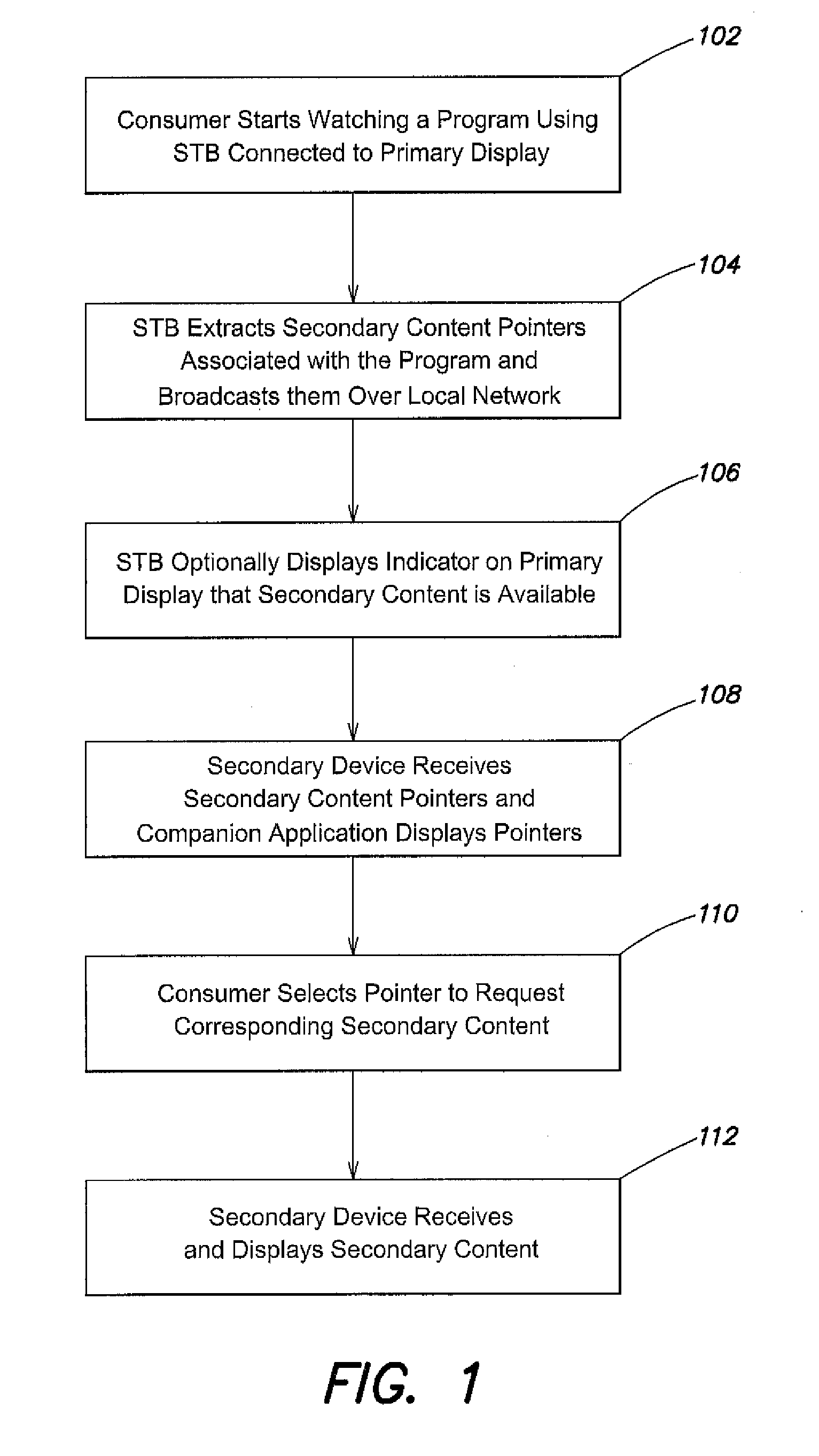Synchronous multi-platform content consumption
a multi-platform, content technology, applied in the direction of selective content distribution, closed-circuit television system, television system, etc., can solve the problems of programmer losing potential revenue from advertising, merchandising, and other commercial tie-ins, and consumers to leave the experien
- Summary
- Abstract
- Description
- Claims
- Application Information
AI Technical Summary
Benefits of technology
Problems solved by technology
Method used
Image
Examples
example 1
Nature Program on Television
[0039]In the first example, a viewer at home begins watching an episode of a program on sharks featuring hammerhead sharks. As the program begins, an icon appears on the lower third of the television indicating that this program includes enhanced content that may be viewed on a personal mobile device. The viewer accesses an application on a tablet computer, and upon launch, the application synchronizes itself to the television and begins displaying content that is synchronized with the shark program. Three minutes into the program, the program cuts to an interview with a shark expert. The tablet displays a picture of the expert obtained via a link in a companion packet using, for example, the following XML instructions:
100100:03:02:21http: / / www.sharkloverstelevision.com / synctv / contentTitlehammerheadweek / hammerhead / titlegraphic.jpgDr. Smith Image hammerheadweek / hammerhead / evansmith.jpg Dr. Smith BioTOChammerheadweek / hammerhead / TOC.html
In the above, Plink ...
example 2
Live Sporting Event—Figure Skating
[0041]As the event kicks off in a packed venue, a JumboTron display indicates that the event supports synchronized secondary content. Members of the audience access an application on their smart phones, which synchronizes them with the in-stadium display through the venue's wireless LAN. A particular audience member has a poor seat, and is not able to see which skater just pulled off a triple axle. She looks at her phone where event statistics are updated in real time, and clicks on the most recent jump, which responds by providing a list of jumps in the skater's program. She then clicks on the skater in question to obtain the video replay for a specific jump. If the JumboTron fails to show a good view of the jump, the fan accesses an instant replay function, and is able to see the jump from multiple angles.
[0042]The audience member may also wish to see a history of the skater's scores from previous events or a biography. A link to this content is d...
example 3
Televised Sporting Event
[0043]During the pre-game show, two friends launch the synchronized content application on their portable devices, which synchronize with the primary program. One friend plays Fantasy Football, an interactive virtual competition, and also uses her portable device to track player results in real time. The other friend uses the application on her personal portable device to probe for deeper pre-game analysis. Each person is able to choose from a list of widgets that can be displayed within the application, some of which may be synchronized with the main display, and some which may not. The synchronized items are updated in real time from various remote sources.
[0044]The methods and systems described herein may also be used in connection with primary audio-only programs, both live and pre-recorded. For audio, the system configuration is similar to that illustrated in FIG. 2, but with the set-top box and the television replaced by a digital audio processing and o...
PUM
 Login to View More
Login to View More Abstract
Description
Claims
Application Information
 Login to View More
Login to View More - R&D
- Intellectual Property
- Life Sciences
- Materials
- Tech Scout
- Unparalleled Data Quality
- Higher Quality Content
- 60% Fewer Hallucinations
Browse by: Latest US Patents, China's latest patents, Technical Efficacy Thesaurus, Application Domain, Technology Topic, Popular Technical Reports.
© 2025 PatSnap. All rights reserved.Legal|Privacy policy|Modern Slavery Act Transparency Statement|Sitemap|About US| Contact US: help@patsnap.com



